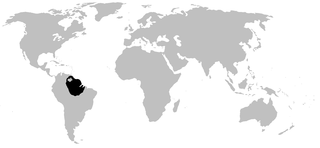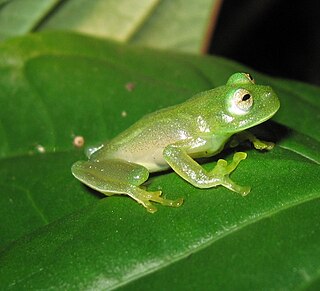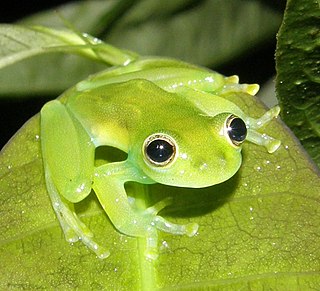
The glass frogs are frogs of the amphibian family Centrolenidae. While the general background coloration of most glass frogs is primarily lime green, the abdominal skin of some members of this family is transparent and translucent. The internal viscera, including the heart, liver, and gastrointestinal tract, are visible through the skin, hence the common name is given as glass frog. Glass frogs are arboreal, meaning they mainly live in trees, and only come out for mating season.

The Tukeit Hill frogs are three species of frog in the genus Allophryne. Originally erected for the species Allophryne ruthveni, the genus was placed as the only member of the subfamily Allophryninae, which was in turn placed in the family Centrolenidae, but they are now considered as the only genus in the monotypic family Allophrynidae.

Cochranella is a genus of glass frogs, family Centrolenidae. They are found in Central America from Honduras southward to the Amazonian and Andean cloud forests of Colombia, Ecuador, Peru, and Bolivia.

Hyalinobatrachium is a genus of glass frogs, family Centrolenidae. They are widely distributed in the Americas, from tropical Mexico to southeastern Brazil and Argentina.
"Centrolene" medemi is a species of frog in the family Centrolenidae. The species occurs in the Cordillera Oriental in the Tolima, Caquetá, and Putumayo Departments in Colombia and adjacent Napo in Ecuador. The generic placement of this species within the subfamily Centroleninae is uncertain. The specific name medemi honors Fred Medem, collector of the holotype. Common name Medem giant glass frog has been coined for it.

Ikakogi tayrona, or the Magdalena giant glass frog, is a species of frog in the family Centrolenidae. It is endemic to the Sierra Nevada de Santa Marta, Magdalena Department, Colombia. It is the only glass frog that is known to show maternal care.
"Cochranella" duidaeana, commonly known as the Duida Cochran frog, is a species of frog in the family Centrolenidae. It is endemic to Cerro Duida, Venezuela. The generic placement of this species within the subfamily Centroleninae is uncertain.
"Cochranella" xanthocheridia is a species of frog in the family Centrolenidae. It has an uncertain generic placement within subfamily Centroleninae; molecular data are not available and morphological and behavioural characters do not unambiguously place it in any specific genus.

Nymphargus is a genus of glass frogs in the subfamily Centroleninae, which was established in 2007. They are distributed in the Andean slopes of Colombia, Ecuador, Peru, and Bolivia. They are characterized by lacking webbing among the outer fingers, lacking humeral spines in adult males, and having a lobed liver covered by a transparent hepatic peritoneum.

Centroleninae is one of two subfamilies of the family Centrolenidae. It has nine genera distributed in Central America from Honduras south and east to northern and central South America. As of mid 2015, it contains 117 species.

Vitreorana is a genus of glass frogs that are native to South America, from the Atlantic Forest of Brazil and Argentina to the Amazon rainforest of Colombia and Ecuador and to the Venezuelan Coastal Range and the Guianas.

Teratohyla is a small genus of glassfrogs in the subfamily Centroleninae. The genus was for a while included in Centrolenella and then Cochranella, but it was resurrected in 2009. These frogs are distributed from lowlands of Central America from Honduras southwards to Pacific and Amazonian wet tropical lowlands of South America.

Hyalinobatrachinae is a subfamily of glass frogs that was established in 2009. They are found in the Americas from Mexico south to southeastern Brazil and Argentina.
Celsiella is a small genus of glass frogs endemic to Venezuela. It was established in 2009 and named in honour of Josefa Celsa Señaris, nicknamed "Celsi", a Venezuelan herpetologist who had worked with glass frogs.

Chimerella is a small genus of glass frogs, family Centrolenidae. They are found on the Amazonian slopes of the Andes in Ecuador and Peru, possibly extending into Colombia.

Espadarana is a genus of glass frogs. They are found in Central America and northern South America.

Sachatamia is a small genus of glass frogs. They are found in Central America and northern South America at altitudes below 1,500 m (4,900 ft) above sea level.

Rulyrana is a small genus of glass frogs. They are found in South America, on the Amazonian slopes of the Andes in Ecuador, Peru, and possibly Bolivia, as well as on the eastern slopes of the Cordillera Central and the western slopes of the Cordillera Oriental in Colombia.
Juan Manuel Guayasamin is an Ecuadorian biologist. He earned his Ph.D. in 2007 from University of Kansas, Department of Ecology and Evolutionary Biology and as of 2017 he is working as professor at Universidad San Francisco de Quito in Ecuador. His research interests include the evolution of glass frogs (Centrolenidae) and direct-developing anurans. His main contributions have been: phylogenetic taxonomy of glassfrogs, description of the variation of skin texture in frogs, description of numerous species of amphibians and reptiles, and a monographic review of all Ecuadorian glassfrogs. A team led by Juan M. Guayasamin discovered Hyalinobatrachium yaku in May 2017, a glassfrog with transparent venter. To date (2020), he has described a total of 6 amphibian genera, 55 species of amphibians, and 11 reptiles, including two geckos from the Galápagos Islands.













